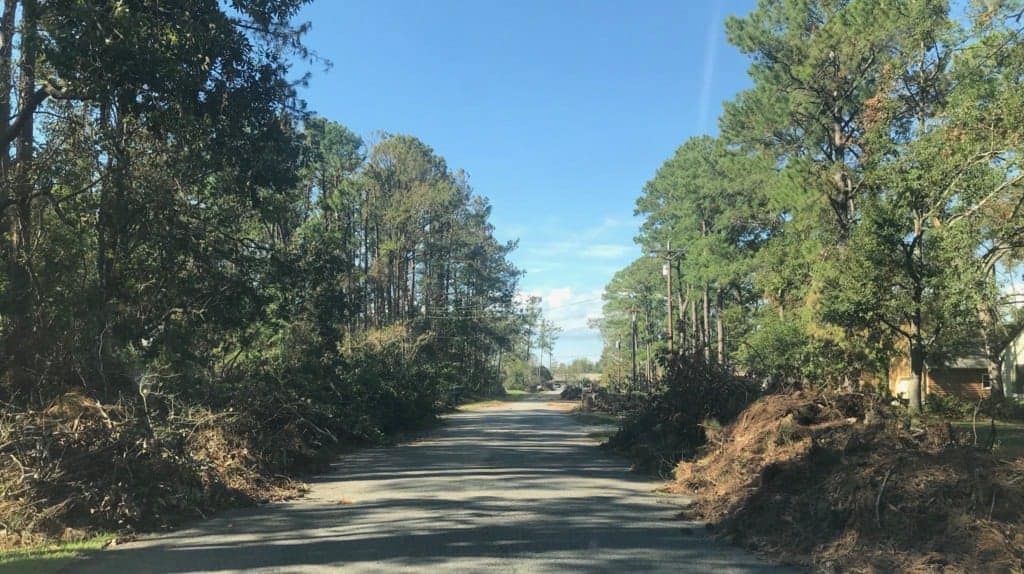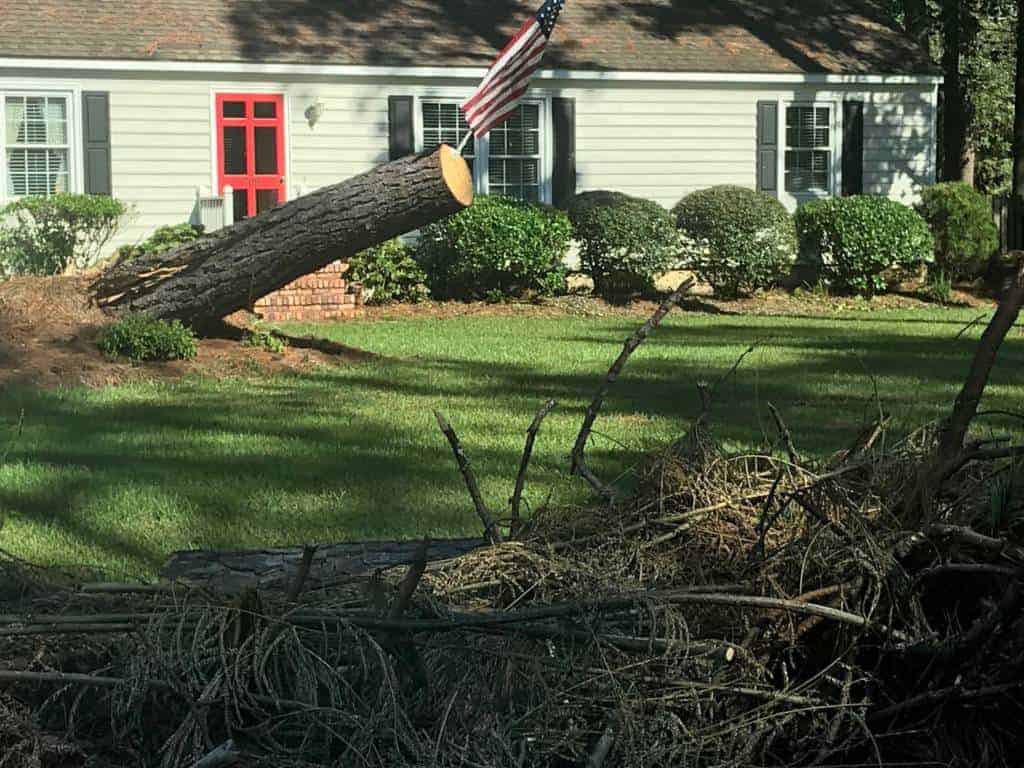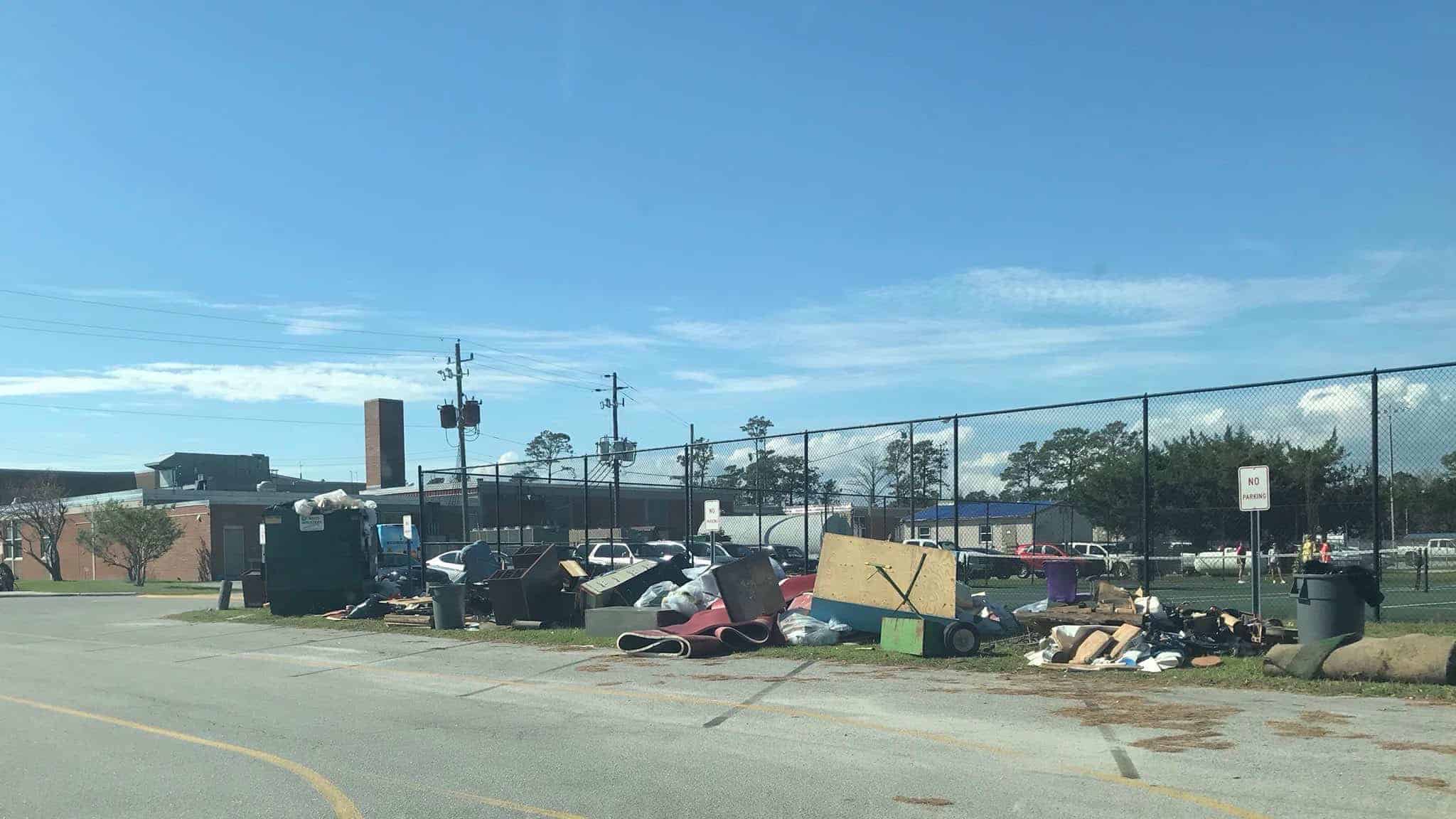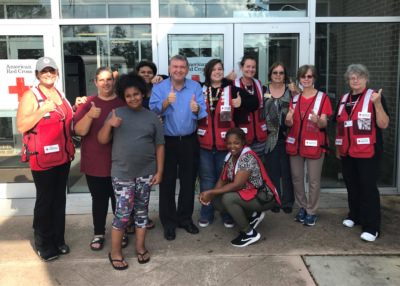As students in Carteret County returned to school Tuesday, arriving buses and cars were greeted by teachers standing and jumping outside, waving and shouting their welcomes. It’s a tradition here that occurs on the first day of each school year. After Florence and its aftermath, this was emblematic of a new beginning.
“A second ‘first day,'” school board member John McLean said. “And I applaud [it]. With everything that everybody is going through, I think that was a great, great call.”
School officials believe about 400 students and 60 teachers have been displaced from their homes. Much of the impact to schools was roof damage during the storm, which allowed water infiltration.
At Croatan High School, the wind shook the metal roof like a blanket, allowing water penetration as the roof waved up and down. The gymnasium at Broad Creek Middle School has long offered a stunning greeting with a wall of windows at its entrance. These were blown out by Florence and, combined with the three feet of rain, destroyed the gymnasium floor. The auditoriums at East Carteret and West Carteret High Schools took in water, and classrooms at county schools, particularly mobile units, were damaged as well.
Some of this damage can be mopped up and mitigated by cleanup and restoration methods. Other damage, such as damage to gymnasium floors, is irreversible. The assessment is ongoing and repair estimates keep growing, but earlier this week Superintendent Mat Bottoms said that number was already more than $8 million and rising.
“It is about numbers now,” Bottoms said, but weeks ago when he set a recovery plan in motion, “it was about the kids and getting them back to school.”

Reopening schools on Tuesday was quite a feat considering the state of things when crews first re-entered the various campuses. With an estimated 40 percent of damage attributed to mold and mildew threats, delays would have been disastrous. Keith Maready, the construction supervisor for the county’s schools, worked feverishly to find the right contractor to address mold issues and found SouthernCAT out of Florida recommended repeatedly. SouthernCAT principals were already flying to Raleigh, and Maready urged them to get to Carteret quickly before roads prevented their arrival. And when they reached, Maready delivered a challenge.
“The story is Florence,” he told them. “The story is already here. You and I are not going to be another story.”
Crews and volunteers worked furiously to remove water and moisture and treat the damage. They cleaned debris and used dehumidifiers and other water evacuation methods. Then they used filters to clean the air–four times an hour, every hour, for 96 hours. So while the repair figures will be high, it could have been much worse.
“We captured [the damage] where it was,” Maready said. “It’s going to be expensive, but it could have resulted in a lot more expense to let it sit there with no power and no air movement.”
The recovery efforts began even before Florence made landfall, with school officials commissioning air quality testing to determine a benchmark. Bottoms said the air quality is actually better now than it was before (though standard environmental factors mean it is expected to return to base line). And after the storm hit, the recovery efforts continued immediately.
“We could not have put someone in this job that cared more about this county,” McLean said.
On Friday, conditions were still dangerous, with evacuated residents told to stay away and remaining residents encouraged to stay off the roads for their own safety. Nevertheless, Bottoms had taken to the streets to see his schools, assess the damage, and put together a comprehensive action plan. He texted that he was determined to get to as many schools as possible to survey the damage and begin planning. As he was driving, he stopped by the houses of people he knew who had evacuated and texted them updates on their homes.

When contractors mentioned bringing in laborers to help with their efforts, Bottoms convinced them instead to let him post the work needed on local boards so that employees, non-benefit school personnel, and other county residents without work could benefit from the pay.
Meanwhile, Frankie Sartin, who is in charge of the district’s cafeterias and child nutrition, worked with federal and state officials to get assistance for impacted families, including free breakfasts and lunches through November. One mom pulled a school board member aside to say how much this gesture has meant. Her family doesn’t qualify for assisted lunches, but her kids can eat, she said, because of this.
Sartin also identified more than $150,000 worth of food that would have gone to waste in schools without power and orchestrated efforts to get the food out to shelters and into the community.
In an anonymous letter written to the school board and read at Tuesday’s Board of Education meeting, someone said, “Mat started us all planning and preparing as the forecasts pointed Florence in our direction. He was working all angles and having his team cover all bases … He is a 24/7 superintendent. The last three weeks he has been a 48/14 superintendent.”
For his part, Bottoms thanked his entire team and gave praise to district principals and teachers.
“Our principals have been on the job throughout this,” Bottoms said, citing instances of principals, administrators, and teachers fundraising, helping to feed crews involved with disaster relief efforts, and volunteering their time on cleanup. “Everywhere I turned, our people were there.”
Bottoms also thanked the county and county residents as a whole.
“I cannot say enough about our county,” Bottoms said. “They have said, ‘We’re with you, you’re us. We are one and the same. We’re going to do whatever we can to get our schools back open.'”



